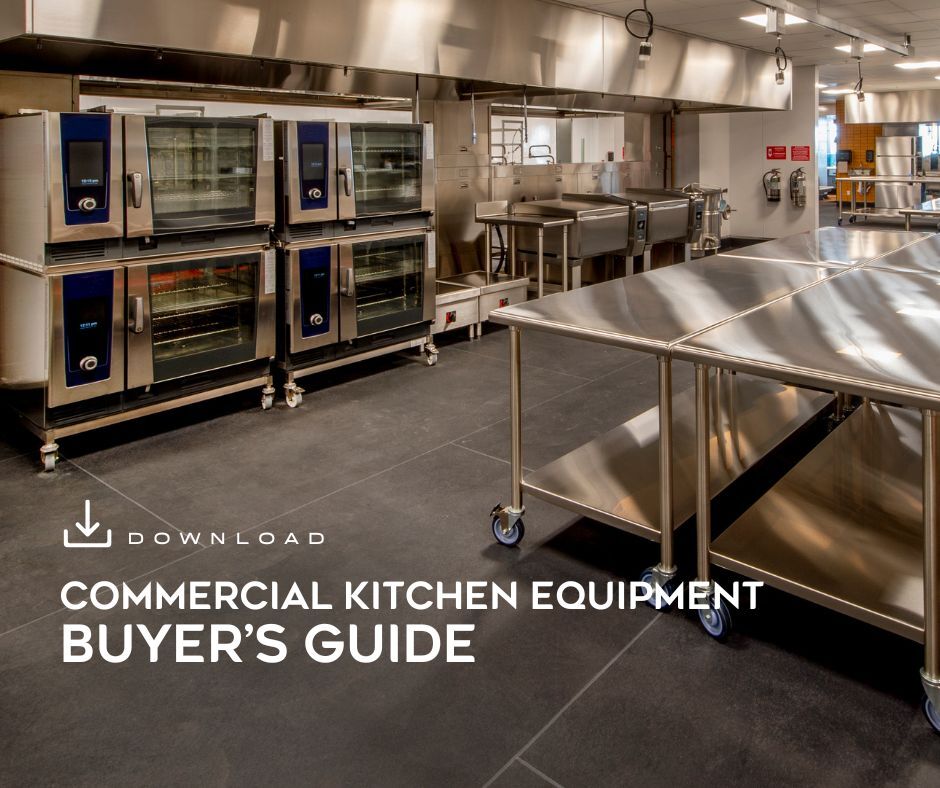1st Nov 2025
What is Commercial Grade Kitchen Equipment?
In every professional kitchen, performance depends on more than people and produce. It depends on the tools that bring consistency, safety, and speed to every service. From restaurants and bakeries to butchers and production kitchens, commercial-grade equipment is the foundation that keeps operations moving. It’s built to handle long hours, heavy loads, and the relentless rhythm of professional food preparation.
The difference between domestic and commercial
Domestic appliances are built for convenience. They are made for occasional use in small batches and controlled environments. Commercial equipment, by contrast, is designed for constant demand. It must cope with the heat, moisture, vibration, and repeated cleaning that define professional kitchens.
The difference begins with materials. Commercial units use stainless steel, high-grade alloys, and heat-resistant polymers that can withstand continual operation. Components are reinforced to prevent wear, seals and joints are engineered for hygiene, and surfaces are designed for fast, thorough cleaning. Every element is built for reliability.
Domestic models often prioritise aesthetic design and compactness. Commercial systems prioritise endurance, serviceability, and compliance. The goal is not to look good on a worktop, but to perform efficiently shift after shift.
Why precision matters
Consistency is the hallmark of professional foodservice. Commercial kitchen equipment must deliver the same result every time, regardless of load, temperature, or ambient conditions. That means precise control of temperature, speed, and timing.
High-quality catering machinery uses thermostatic accuracy, calibrated timers, and feedback sensors to maintain stability. Whether it’s an oven maintaining a steady 180°C or a mixer running at a consistent speed, precision translates directly to quality and efficiency. It allows teams to plan service confidently and eliminates waste caused by overcooking, undercooking, or inconsistent output.
Refurbished catering equipment
For refurbished catering equipment, precision is just as important. Every reconditioned item must be tested to meet the same performance standards as new. At Herits, refurbished machines are recalibrated, cleaned, and verified by engineers so they deliver professional-grade control and reliability from the first day of installation.
The unseen advantages of design and build
Commercial kitchen equipment isn’t just about durability; it’s about design that supports workflow. Handles, trays, baskets, and hinges are built to withstand frequent handling. Panels are reinforced to prevent vibration, which protects both the operator and the machine. Even the spacing of components inside units such as ovens and chillers is planned to improve airflow, reduce stress, and extend life.
The difference becomes clear when you compare servicing intervals. A domestic dishwasher might last seven years with regular use. A commercial dishwasher, with regular maintenance, can last more than fifteen years, even with continuous operation. That longevity translates to better return on investment and lower waste across the industry.
Smarter features for modern kitchens
The new generation of commercial kitchen equipment brings intelligence as well as strength. Programmable controls and digital monitoring are now essential for efficiency and safety. Smart systems log usage data, monitor temperatures in real time, and alert operators to potential faults before they cause disruption.
This technology has moved from luxury to necessity. In a busy kitchen, connected systems make it easier to manage equipment fleets and improve accountability. When data is available instantly, managers can optimise performance, reduce energy use, and schedule maintenance before problems appear.
Refurbished models often incorporate modern upgrades such as energy-efficient components or improved control interfaces. This allows businesses to benefit from contemporary performance while staying within budget.
Energy efficiency and sustainability
Energy management is one of the most important trends shaping commercial catering. Rising costs and environmental targets have made efficiency central to equipment choice. Machines that use less energy not only reduce operating costs but also contribute to your sustainability goals.
Commercial equipment manufacturers have responded with innovations in insulation, burner design, and motor control. Many modern appliances now include standby modes or demand-based power adjustment to reduce energy use during quieter periods.
Refurbishment plays an equally important role in sustainability
Every reconditioned machine prevents a new one from being manufactured and an old one from being scrapped. The environmental savings from refurbishment are significant, often cutting embodied carbon emissions by more than fifty percent. Herits supports this circular approach by reusing, restoring, and repurposing commercial kitchen equipment wherever possible.
Compliance and safety standards
Every piece of commercial-grade equipment must meet strict safety and hygiene requirements under UK law. Gas appliances must be installed and maintained by Gas Safe registered engineers. Electrical equipment must pass periodic PAT or EICR testing. Surfaces must be designed for food-safe cleaning, and ventilation systems must provide adequate airflow for safe operation.
These standards are not optional. They protect staff and customers and are a legal foundation for any professional kitchen. When buying refurbished equipment, documentation and certification are vital. Reputable suppliers like Herits provide full compliance paperwork, giving operators confidence that their investment meets all required standards.
Planning for the long term
Investing in commercial-grade equipment is about building a kitchen that lasts. It’s not just a purchase; it’s a commitment to reliability, safety, and productivity. Businesses that take the time to evaluate performance, maintenance, and total cost of ownership make smarter decisions. They avoid unnecessary downtime and reduce both financial and environmental waste.
Refurbished catering equipment adds flexibility to this strategy. It allows businesses to scale up, test new concepts, or replace ageing units without overstretching capital budgets.
"When backed by engineering expertise and transparent refurbishment processes, refurbished options deliver the same dependability as new."
Commercial-grade equipment defines the rhythm of professional kitchens. It blends power, control, and resilience with modern technology that supports smarter, more sustainable operations. Whether new or refurbished, the best equipment pays for itself through reliability and longevity.
Herits exists to make that decision easier. We help food businesses find the right balance of performance, value, and sustainability. We deliver equipment that keeps working as hard as the people who use it.


